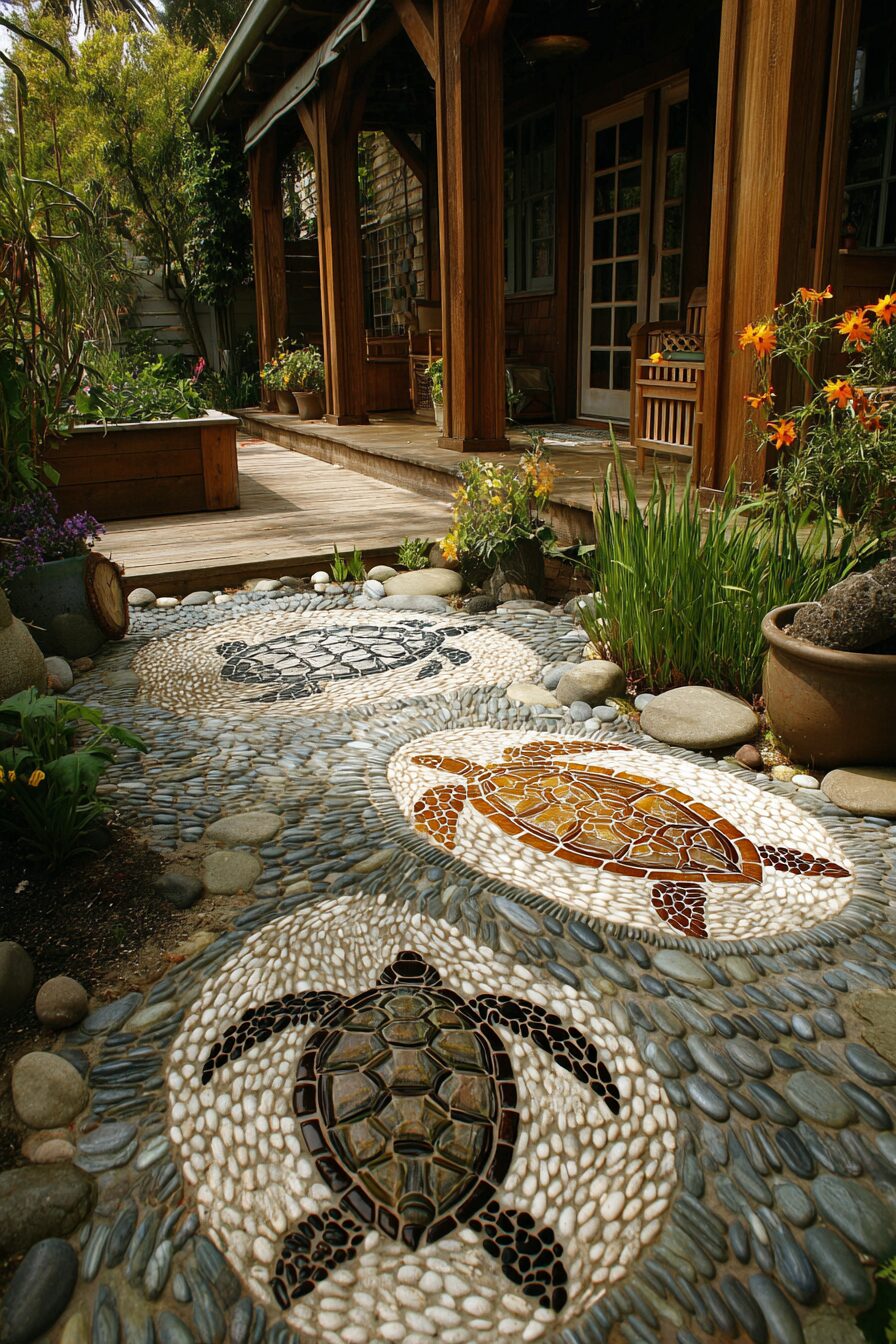Nature’s artistry meets human creativity in the timeless craft of pebble mosaics.
These stunning installations combine smooth stones in intricate patterns that can elevate any outdoor space from ordinary to extraordinary.
Mesmerizing Spiral Pathways
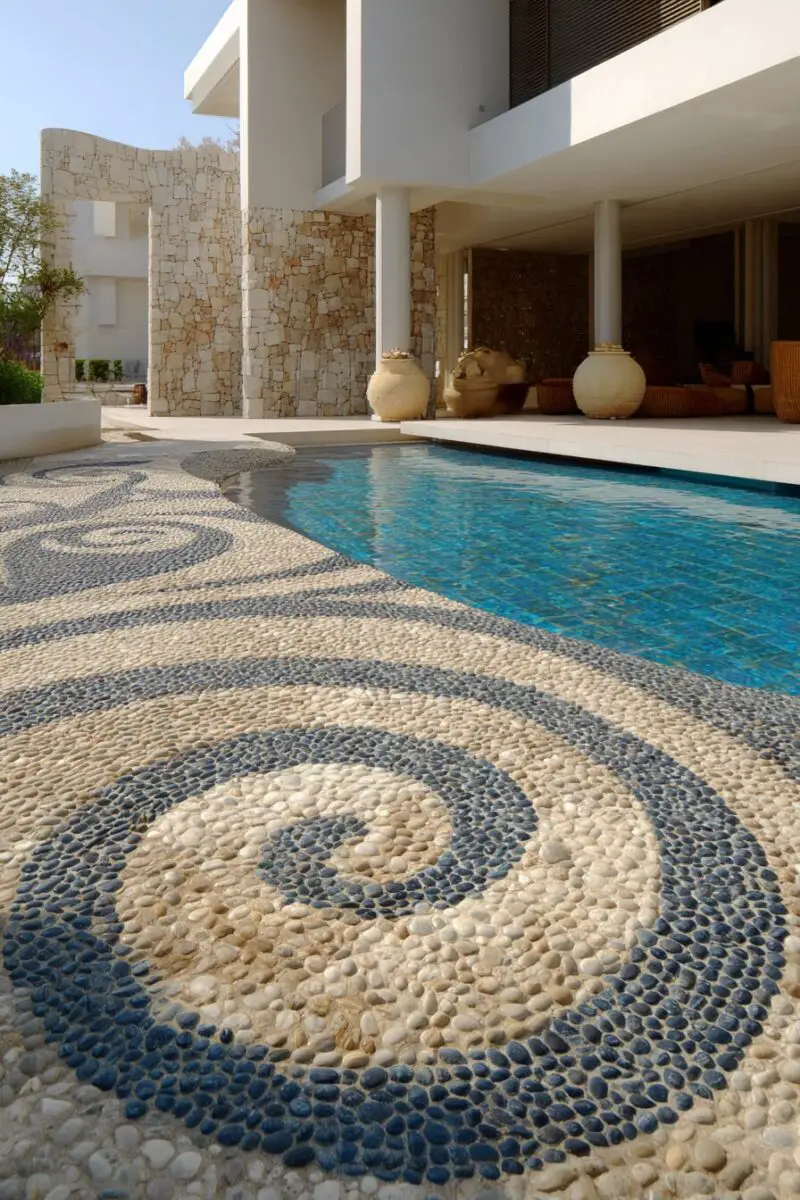
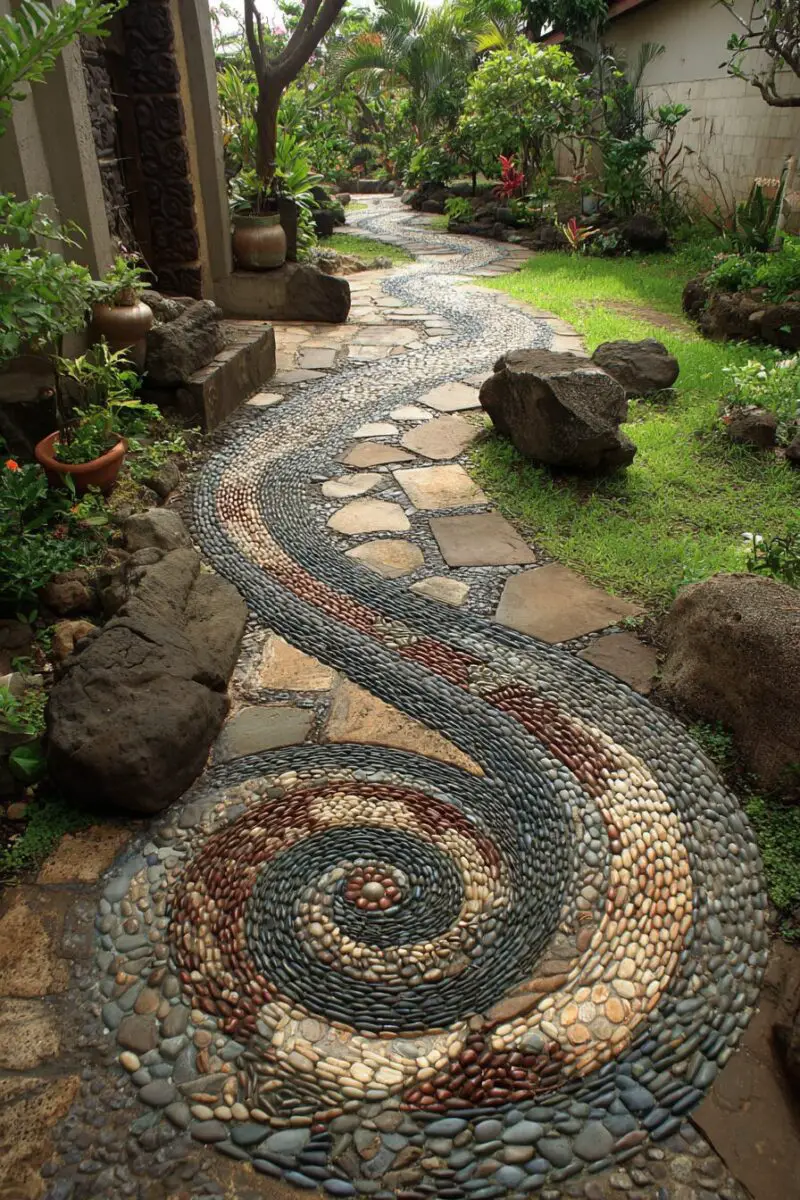
Nothing captures attention quite like a spiral pebble pathway winding through your garden landscape.
The hypnotic swirl pattern creates a sense of journey and movement that draws the eye and invites exploration.
Spirals connect deeply with human psychology, representing growth, evolution, and the passage of time.
When creating a spiral pathway, consider using contrasting colors to accentuate the curve—perhaps dark river rocks against lighter quartz pebbles.
The magic of spiral designs lies in their versatility: they can be compact centerpieces in small gardens or elaborate walkways in larger spaces.
For best results, start your spiral from the center and work outward, maintaining consistent spacing between stones.
To enhance the design’s definition, use flexible garden edging or slightly sunken installation to prevent pebbles from migrating over time.
A spiral pathway looks particularly enchanting when surrounded by low-growing ground covers like creeping thyme or Irish moss that soften the edges.
For nighttime drama, consider adding subtle pathway lighting that highlights the contours of your spiral, creating magical shadow patterns.
The mathematical precision of a well-executed spiral creates a sense of order and intention that can transform even the most ordinary garden corner.
Captivating Animal Motifs
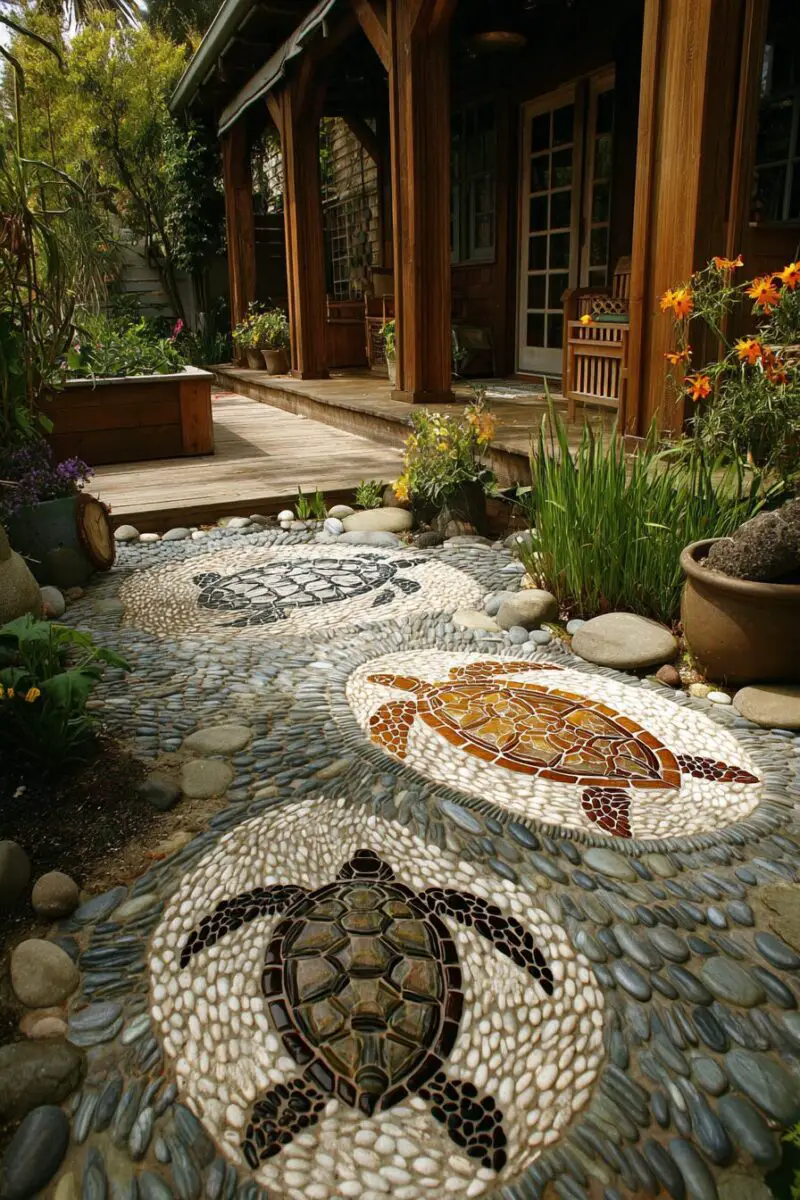
Imagine stepping into your garden and being greeted by the friendly face of an owl, the graceful silhouette of a deer, or the playful outline of a fish—all created entirely from carefully placed pebbles.
Animal motifs bring character, whimsy, and personal meaning to outdoor spaces in a way few other design elements can match.
The key to successful animal motifs lies in thoughtful simplification—focus on distinctive outlines and characteristic features rather than attempting photorealistic detail.
Birds are particularly popular choices, with their recognizable shapes and the spiritual associations many cultures attribute to them.
For more complex designs, consider creating a template first, outlining your animal shape with rope or garden hose before beginning stone placement.
Choose pebble colors that either mimic the natural coloration of your chosen animal or create artistic contrast that makes the design pop.
Scale matters significantly with animal motifs—a small bird design might work beautifully as a stepping stone, while larger creatures like deer or tortoises might spread across an entire patio section.
The spaces between pebbles become important design elements too; consider using dark sand or crushed black stone to fill gaps and emphasize your animal’s outline.
Don’t be afraid to incorporate other materials sparingly—a particularly special stone or piece of sea glass can become an eye or focal point within your animal design.
For maximum impact, position animal motifs where they’ll be regularly seen and appreciated, such as near seating areas or along frequently traveled garden paths.
Design Your Dream Room in Minutes!
🏡 Start Creating FREE →Tranquil Mandala Patterns
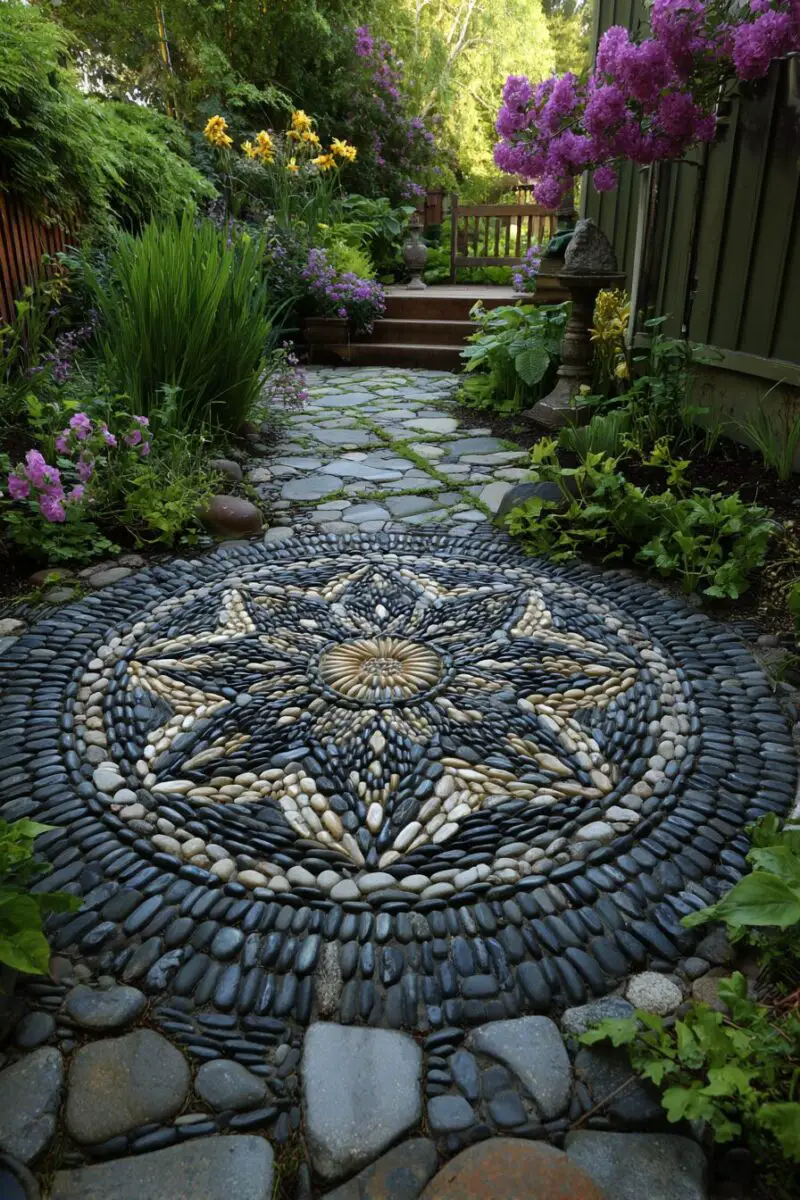
Few pebble designs carry the immediate visual impact and spiritual resonance of a carefully crafted mandala.
These circular, symmetrical patterns radiate outward from a central point, creating a powerful sense of harmony and completeness that can transform an ordinary garden space into a meditation sanctuary.
The word “mandala” comes from Sanskrit, meaning “circle,” and represents wholeness and the connection between inner and outer worlds.
Creating a pebble mandala begins with establishing a perfect circle and its center point, often using string attached to a central stake to ensure geometric precision.
The most effective mandala designs typically feature clearly defined rings that progress outward, each with its own pattern or stone type.
Color plays a crucial role in mandala impact; traditional designs often incorporate whites, blues, and earth tones, but your palette should reflect your personal aesthetic.
Many garden designers incorporate symbolic elements into their mandalas—perhaps using four sections to represent the seasons or elements, or eight divisions to represent compass directions.
A pebble mandala makes an ideal focal point for a meditation garden, especially when surrounded by circular plantings that echo and enhance its shape.
For truly spectacular results, consider slightly doming the center of your mandala to create subtle three-dimensionality that catches light and shadow throughout the day.
The repetitive, precise nature of creating a mandala can itself become a meditative practice, making this not just a beautiful addition to your outdoor space but a meaningful journey.
TRENDING NOW
13 Boho Patio Ideas For Enchanting Outdoor SpacesDynamic Flowing Water Patterns
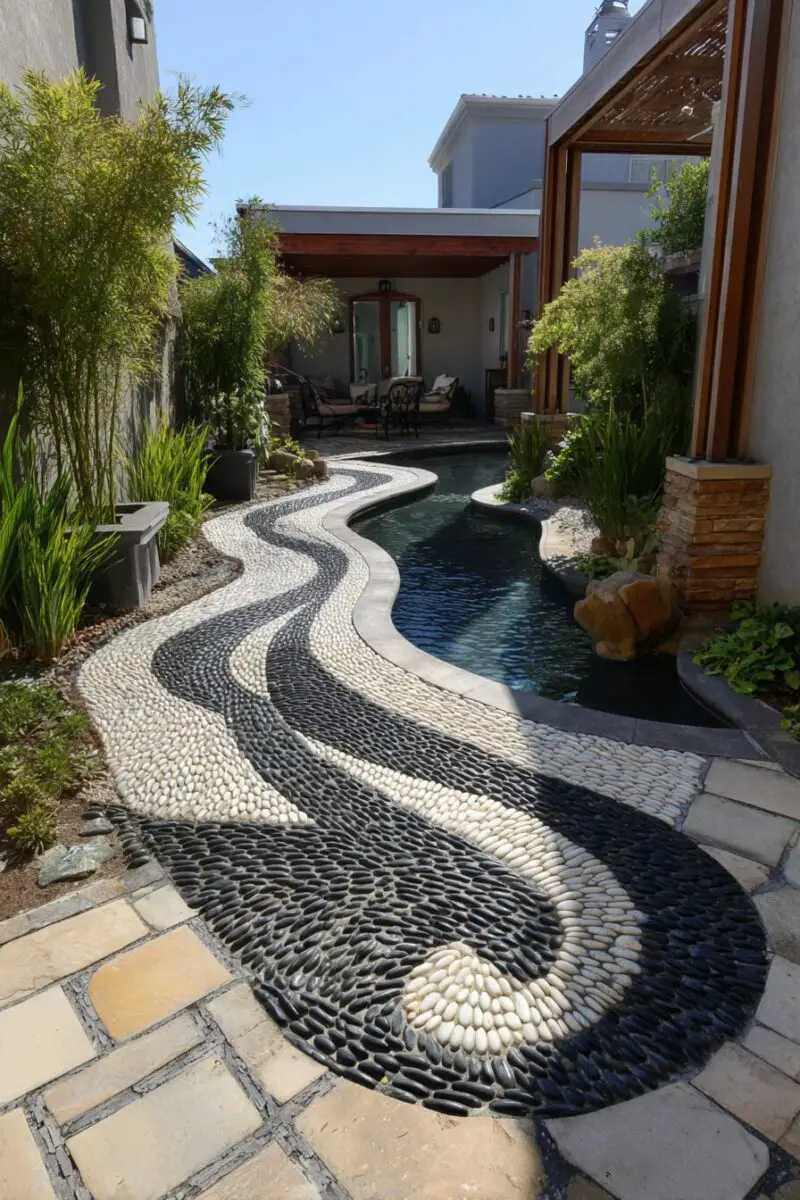
Water-inspired pebble mosaics bring the soothing, dynamic energy of rivers, oceans, and streams directly into your landscape—without the maintenance actual water features require.
These sinuous designs mimic the natural movement of water, creating a sense of flow and continuity that can visually connect different areas of your garden.
Blue, turquoise, white, and gray pebbles arranged in wave-like patterns create an immediate visual association with water, especially when installed in areas that would naturally feature water, like dry creek beds.
The beauty of water-inspired designs lies in their fluidity—unlike geometric patterns, these mosaics embrace organic curves and asymmetry.
For maximum authenticity, vary the size and shape of your stones, using smaller, rounder pebbles to represent faster-moving sections and larger, flatter stones for calmer pools.
Combining your pebble “water” with actual water-loving plants like ferns, hostas, and Japanese irises enhances the illusion and creates a cohesive microenvironment.
Many successful water-pattern mosaics incorporate actual bridge elements—perhaps a small wooden footbridge or stepping stones that appear to cross your pebble “stream.”
Lighting becomes particularly magical with water-inspired designs, as evening illumination can create shimmer effects that further enhance the watery illusion.
The psychological benefits of water elements in landscapes are well-documented—even representational water features like pebble mosaics can evoke feelings of tranquility and refreshment.
Bold Geometric Precision

Geometric pebble mosaics offer a striking contrast to the typically organic shapes found in garden settings, creating powerful visual tension that immediately captures attention.
These designs harness the timeless appeal of perfect shapes—circles, squares, triangles, hexagons—arranged in patterns that demonstrate human precision against nature’s backdrop.
Modern interpretations of geometric pebble work often draw inspiration from mid-century design, using bold, clean lines and high-contrast color combinations for dramatic effect.
The key to successful geometric mosaics lies in meticulous planning and execution—even slight misalignments become noticeable in designs based on mathematical precision.
Herringbone and chevron patterns translate beautifully to pebble applications, especially when created with stones of uniform size but contrasting colors.
For truly sophisticated results, explore geometric progressions where patterns transform gradually across the installation, perhaps from dense arrangements to more sparse placements.
Checkerboard designs offer perhaps the most striking visual impact with relatively simple execution, especially when created with strongly contrasting stone colors.
The crisp edges of geometric designs can be enhanced by using metal, wood, or concrete dividers between different sections, adding further definition and preventing pattern migration.
Geometric pebble mosaics pair particularly well with modern architectural styles and minimalist plantings, creating cohesive outdoor spaces that feel intentionally designed rather than organically evolved.
TRENDING NOW
13 Outdoor Gazebo Ideas To Transform Your BackyardExpressive Word Art and Symbols
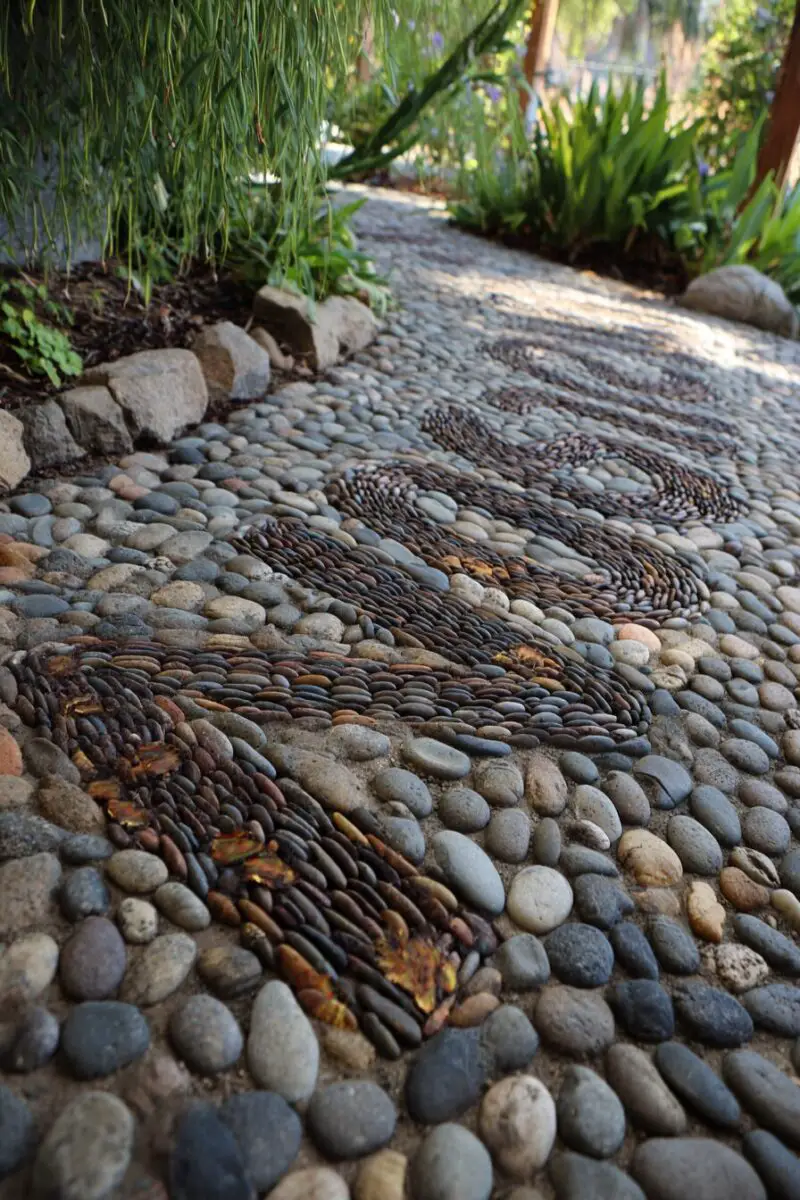
Pebble mosaics that incorporate meaningful words, phrases, or symbols transform ordinary pathways into personal statements that speak directly to visitors and residents alike.
Whether it’s a simple “Welcome” at your garden entrance, your family name near the driveway, or an inspiring quote along a meditation path, word art pebble mosaics combine function with deeply personal expression.
The best word designs balance legibility with artistic merit—letters must be recognizable while still maintaining the beautiful, organic quality inherent to pebble work.
Script fonts generally translate more successfully to pebble medium than block letters, as their flowing lines work harmoniously with the natural shapes of stones.
For maximum impact, consider creating a contrasting background “field” of one stone type, with letters formed from distinctly different stones—perhaps smooth white quartz letters against a field of darker river rock.
Symbols carry powerful meaning with simpler execution requirements—consider incorporating ancient symbols like spirals, labyrinths, or cultural motifs that hold significance for you.
Remember that less is often more with word art—a single powerful word like “Peace,” “Grow,” or “Dream” can have greater impact than longer phrases that may become visually cluttered.
For practical nighttime visibility, consider embedding subtle solar-powered lights near important words, or using reflective stones for letters that will catch headlights or garden lighting.
Some of the most successful word art installations incorporate multiple languages or scripts that hold special meaning for the household, creating layers of meaning and visual interest.
The spaces between letters become crucial design elements in themselves—consider how these negative spaces contribute to the overall readability and aesthetic of your word mosaic.
Stunning Gradient Color Transitions
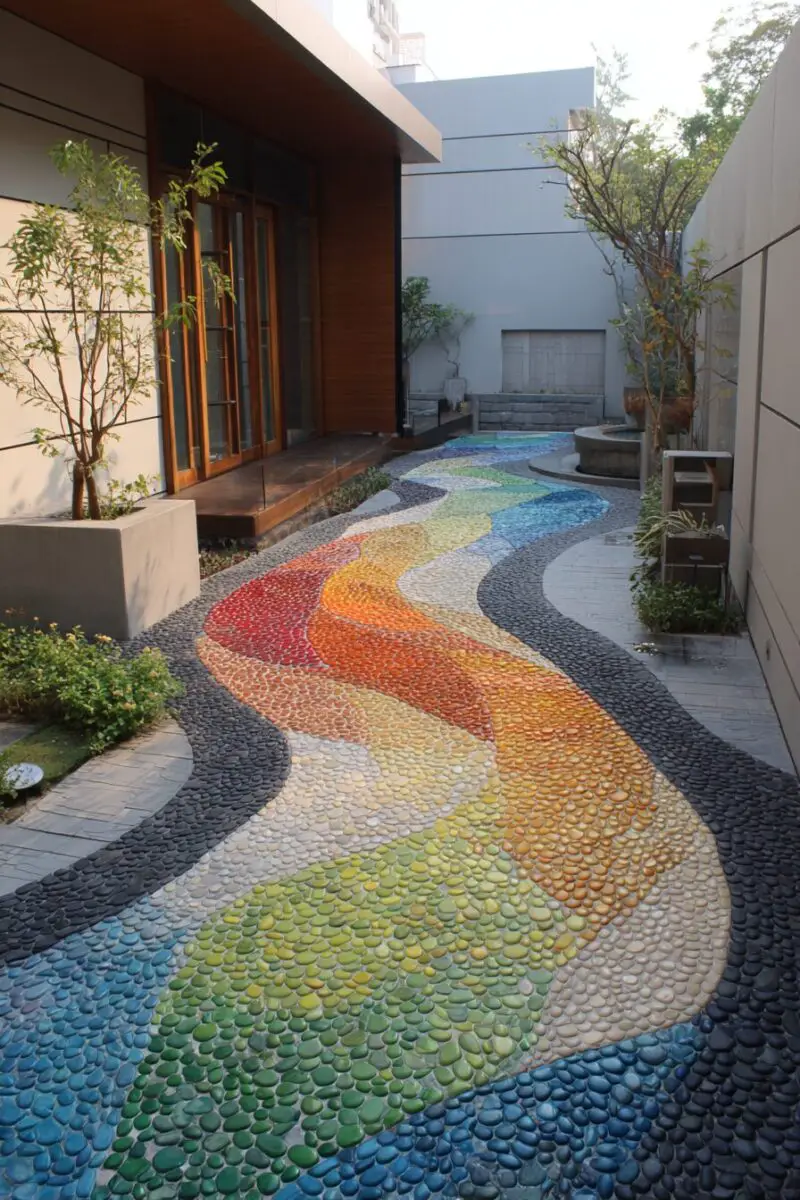
Few pebble mosaic techniques create more immediate visual drama than carefully executed color gradients that transition smoothly from one hue to another across your installation.
These ombre-effect mosaics harness the natural color variations found in stone to create sophisticated, contemporary designs that feel both organic and intentionally artistic.
The secret to successful gradient work lies in collecting a wide spectrum of pebble colors and meticulously sorting them before beginning installation.
Beach-combed stones often provide the most stunning natural color ranges, from deep charcoals through grays and tans to nearly white, allowing for subtle transitions that appear almost painted.
Radial gradients, which transition outward from a central point, create particularly eye-catching focal points for circular garden areas or patio installations.
For maximum impact, align your gradient with existing landscape elements—perhaps transitioning from darker stones near water features to lighter stones near sun-drenched areas.
Horizontal gradients across pathways create a sense of journey and transition, subtly guiding visitors through your landscape with visual cues.
The most sophisticated gradient designs often incorporate not just color transitions but size variations as well, perhaps moving from larger stones of one color to smaller stones of another.
While color is the primary focus of gradient designs, don’t overlook texture variations that can add another dimension to your transitions—perhaps moving from rough, matte stones to polished, reflective ones.
TRENDING NOW
13 Eye-Catching Front Yard Rock Landscaping IdeasEnchanting Celestial Night Sky Patterns

Transform your garden into a perpetual starry night with pebble mosaics that capture the mystery and majesty of celestial patterns.
These designs bring the heavens down to earth, incorporating stars, moons, planets, and constellations into walkways and patios that glow with cosmic energy.
The contrast between dark background stones and lighter “star” elements creates immediate visual impact, especially when experienced under actual moonlight or subtle garden illumination.
Quartz crystals, naturally reflective stones, or small mirrors embedded among darker pebbles create magical twinkling effects that mimic the actual night sky, especially when light plays across them.
For three-dimensional interest, consider slightly raising certain elements—perhaps a crescent moon or particularly important stars—above the main mosaic surface.
The fluid, seemingly random distribution of stars provides forgiveness for beginners; unlike geometric patterns, celestial designs embrace natural irregularity and spontaneous placement.
Glow-in-the-dark elements, while not traditional, can create truly magical effects for contemporary installations, charging during daylight hours and revealing hidden patterns after dark.
Celestial mosaics pair beautifully with night-blooming garden plants like evening primrose or moonflower, creating multisensory spaces that come alive after sunset.
For practical pathways, ensure that any significantly raised elements won’t create tripping hazards, or reserve more dramatic three-dimensional features for areas meant for viewing rather than walking.
Welcoming Doorway Threshold Designs
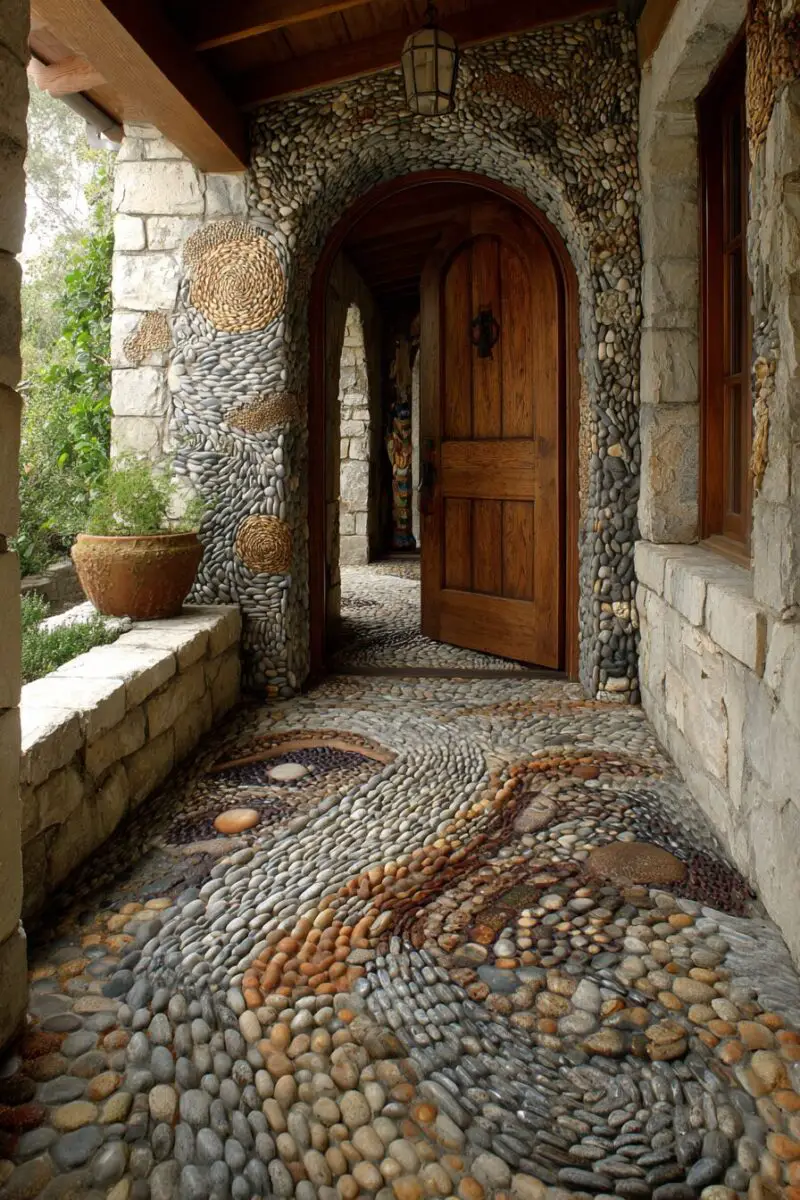
The threshold between worlds deserves special attention, and pebble mosaics at entryways create powerful first impressions while symbolizing the transition from public to private space.
These practical yet beautiful installations set the tone for your entire property, greeting visitors with artistry that hints at the care and creativity they’ll find beyond.
Traditional welcome mosaics often incorporate symbols of hospitality from various cultures—pineapples, certain geometric patterns, or stylized sun motifs that universally communicate warmth.
For practical durability in these high-traffic areas, set pebbles in mortar rather than loose applications, and select stones with flat profiles that won’t create tripping hazards.
Many successful threshold designs incorporate the house number or family name, transforming a functional identifier into an artistic statement.
Weather considerations become particularly important for entryway mosaics; in snowy climates, textured designs can provide additional traction, while rainy regions benefit from patterns that visually disguise mud or water spots.
The intimacy of entryway spaces allows for finer detail work than might be practical in larger garden mosaics; this is the perfect location for intricate patterns that invite close inspection.
For cohesive design, consider echoing elements from your interior flooring in your threshold mosaic, creating a harmonious transition between outdoor and indoor spaces.
Lighting your threshold mosaic becomes both a practical safety feature and an opportunity to dramatically highlight your artistry after dark.
TRENDING NOW
12+ Cheap & Easy DIY Backyard Makeover IdeasClassical Mosaic Reinterpretations
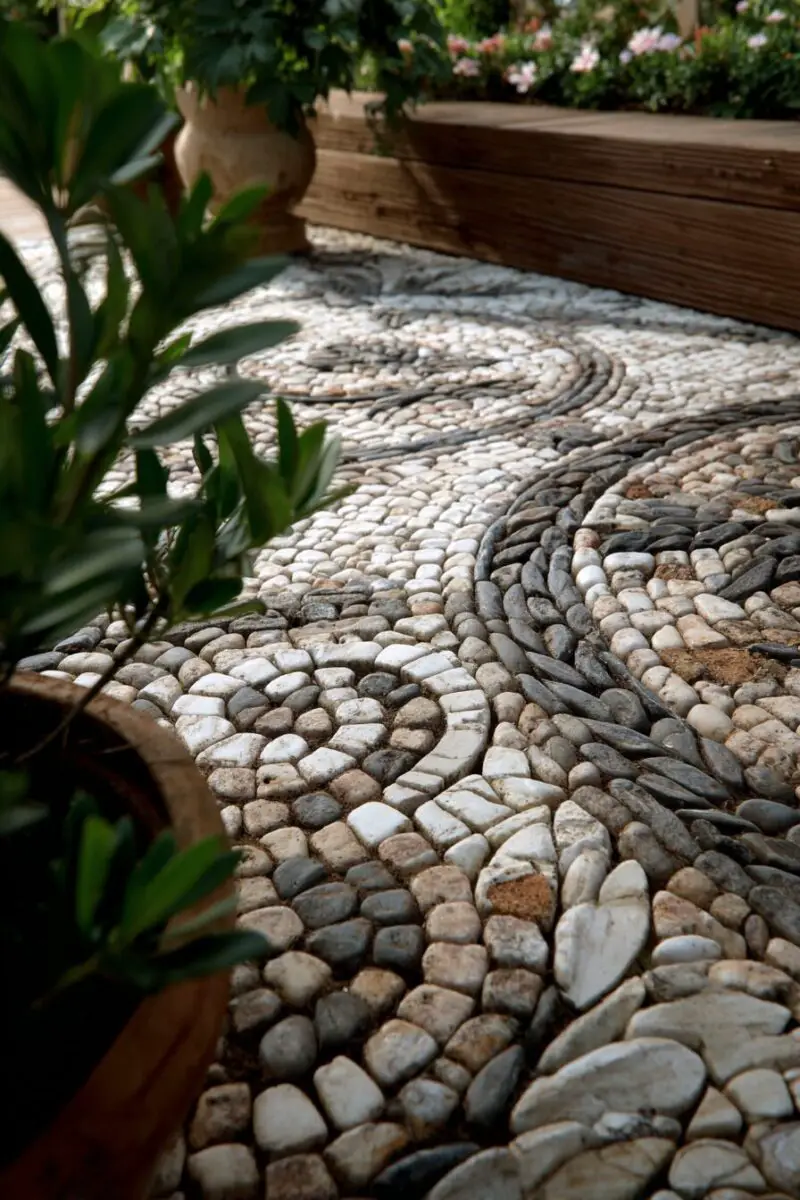
Ancient mosaic traditions from Roman, Greek, Byzantine, and Islamic cultures provide rich inspiration for contemporary pebble work that connects your garden to thousands of years of artistic heritage.
These historical reinterpretations bring sophistication and timelessness to modern landscapes, drawing on pattern languages that have captivated human imagination across centuries and civilizations.
Roman-inspired mosaics often feature mythological scenes or geometric borders that can be simplified and adapted to the more organic medium of pebbles rather than cut tesserae.
Greek key patterns and meanders translate beautifully to pebble work, creating borders and frames that bring classical elegance to garden pathways or patio edges.
Byzantine inspirations often incorporate circular medallions and radiating patterns that work perfectly for central garden features or focal points visible from multiple angles.
Islamic geometric patterns, with their mathematical precision and infinitely repeating elements, create particularly striking pebble mosaics that appear far more complex than their relatively simple underlying structures.
Many historical mosaic traditions featured border treatments that clearly defined the artwork; these frames translate well to pebble medium and help contain more complex central designs.
Rather than attempting exact reproductions, successful reinterpretations capture the spirit and key elements of historical designs while adapting them to contemporary contexts and the unique properties of pebbles.
Research local historical sites for regional inspiration—perhaps your area has indigenous patterning traditions or settler-era decorative arts that could inform your design.
The weathered, imperfect nature of ancient mosaics as they’ve survived through centuries actually pairs beautifully with the natural variations inherent in pebble work, creating an authentic connection to historical precedents.
Start small, collect inspiring stones, and don’t be afraid to let your design evolve organically as you work.
Your unique pebble mosaic will become not just a beautiful addition to your landscape but a personal artistic statement that connects your home to the earth beneath it.

